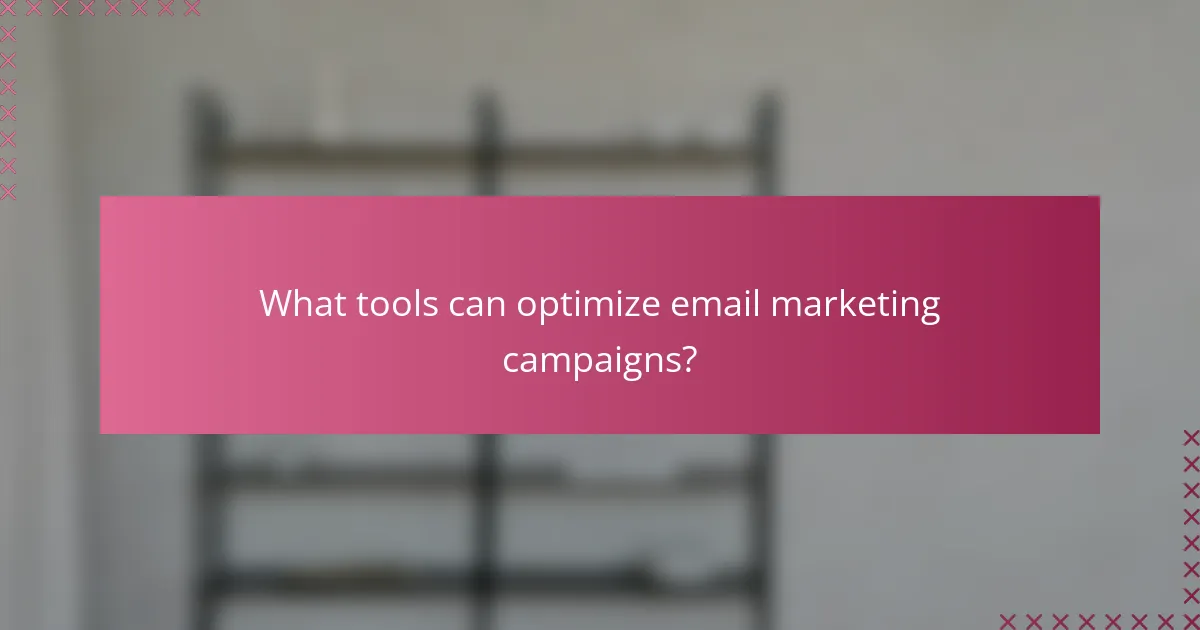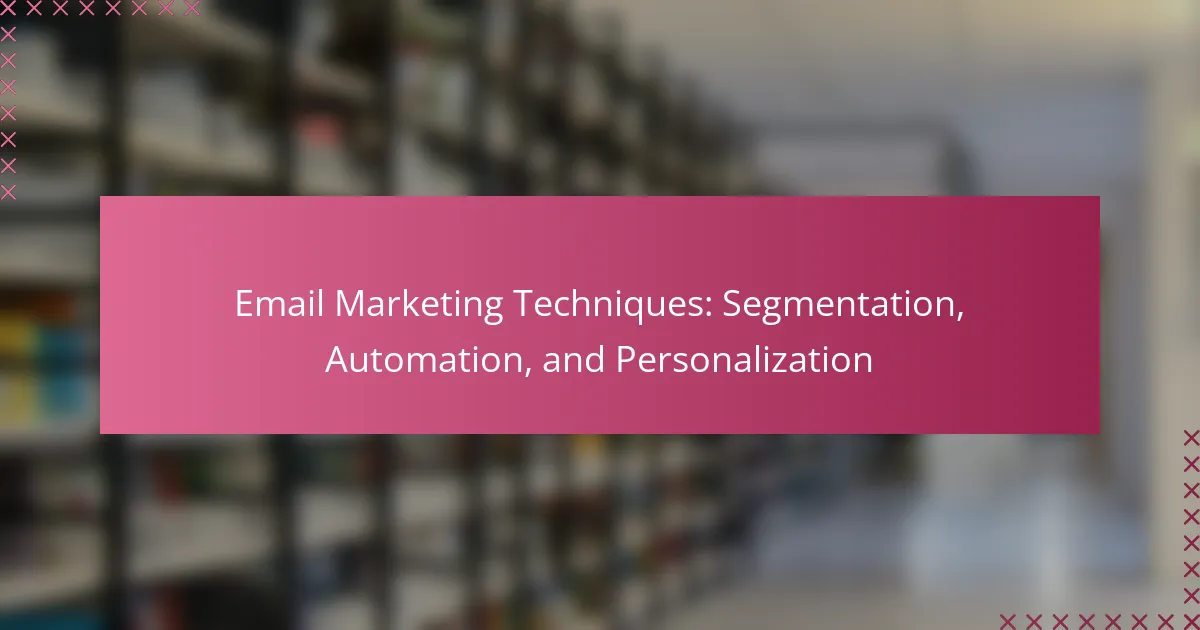Email marketing has evolved into a powerful tool for businesses, leveraging techniques like segmentation, automation, and personalization to enhance engagement and drive conversions. By dividing audiences into specific groups, marketers can deliver tailored content that resonates with each segment. Additionally, automation streamlines processes, allowing for timely communication based on user behavior, while personalization ensures that messages are relevant and meaningful to individual recipients.

What are effective email marketing segmentation strategies?
Effective email marketing segmentation strategies involve dividing your audience into distinct groups based on shared characteristics. This targeted approach enhances engagement by delivering more relevant content to each segment, ultimately improving conversion rates.
Demographic segmentation
Demographic segmentation involves categorizing your audience based on characteristics such as age, gender, income, education, and occupation. For instance, a luxury brand may target high-income individuals with exclusive offers, while a student-focused service might tailor promotions to younger audiences.
When implementing demographic segmentation, consider using data from sign-up forms or customer profiles to create targeted campaigns. This approach can help ensure that your messaging resonates with the specific needs and preferences of each demographic group.
Behavioral segmentation
Behavioral segmentation focuses on how customers interact with your brand, including their purchasing habits, engagement levels, and product usage. By analyzing customer behavior, you can identify patterns that inform your email campaigns, such as sending reminders to users who frequently abandon their carts.
Utilize analytics tools to track customer actions and segment your audience accordingly. For example, you might create separate campaigns for first-time buyers versus repeat customers, tailoring your messaging to encourage loyalty among existing clients.
Geographic segmentation
Geographic segmentation divides your audience based on their physical location, such as country, region, or city. This method is particularly useful for businesses that operate in multiple markets or have location-specific promotions, like local events or seasonal offers.
Consider local customs and cultural nuances when crafting your messages. For instance, a restaurant chain might promote different menu items based on regional preferences, ensuring that the content feels relevant and appealing to each geographic segment.
Psychographic segmentation
Psychographic segmentation categorizes customers based on their interests, values, lifestyles, and personality traits. This approach allows you to create highly personalized content that resonates with your audience on a deeper level, such as targeting environmentally conscious consumers with sustainable product offerings.
To effectively implement psychographic segmentation, conduct surveys or utilize social media insights to gather information about your audience’s preferences. Tailoring your messaging to align with their values can significantly enhance engagement and brand loyalty.
Lifecycle stage segmentation
Lifecycle stage segmentation focuses on where customers are in their journey with your brand, from awareness to consideration to purchase and beyond. By understanding the lifecycle stage of each customer, you can deliver timely and relevant content that guides them through the buying process.
For example, new subscribers might receive a welcome series introducing your brand, while long-time customers could be targeted with loyalty rewards or re-engagement campaigns. This targeted approach helps maintain customer interest and encourages repeat business.

How can automation enhance email marketing?
Automation can significantly enhance email marketing by streamlining processes, improving engagement, and increasing conversion rates. By automating tasks such as sending emails based on user behavior, marketers can deliver timely and relevant content that resonates with their audience.
Triggered email campaigns
Triggered email campaigns are automated messages sent based on specific actions taken by a user, such as signing up for a newsletter or abandoning a shopping cart. These campaigns ensure that the right message reaches the right person at the right time, increasing the likelihood of engagement.
For example, if a customer leaves items in their cart without completing the purchase, a triggered email can remind them of their abandoned items, often including a special offer to encourage completion. This approach can lead to higher conversion rates and improved customer retention.
Drip campaigns
Drip campaigns consist of a series of automated emails sent to users over a set period, designed to nurture leads and guide them through the sales funnel. These campaigns typically start with a welcome email and continue with educational content, product recommendations, or promotional offers.
Marketers should consider the timing and frequency of these emails to avoid overwhelming recipients. A common strategy is to space out emails over a few days or weeks, ensuring that each message builds on the previous one and maintains user interest.
Automated follow-ups
Automated follow-ups are essential for maintaining engagement with customers after an initial interaction. These emails can be triggered by specific events, such as a purchase or a webinar registration, and serve to thank the recipient, provide additional information, or solicit feedback.
For instance, after a customer makes a purchase, an automated follow-up email can include tips on how to use the product or suggest related items. This not only enhances the customer experience but also opens opportunities for upselling or cross-selling.
Performance tracking automation
Performance tracking automation involves using tools to monitor and analyze the effectiveness of email campaigns in real-time. By automating this process, marketers can quickly identify which emails are performing well and which need adjustments.
Key metrics to track include open rates, click-through rates, and conversion rates. Setting up automated reports can help marketers make data-driven decisions, allowing for timely optimizations that enhance overall campaign performance.

What are the benefits of personalization in email marketing?
Personalization in email marketing enhances the relevance of messages sent to recipients, leading to improved engagement and conversion rates. By tailoring content to individual preferences and behaviors, businesses can create more meaningful interactions with their audience.
Increased engagement rates
Personalized emails typically see higher engagement rates compared to generic messages. When recipients receive content that resonates with their interests, they are more likely to open, read, and interact with the email. For instance, using a recipient’s name or recommending products based on past purchases can significantly boost engagement.
Consider segmenting your email list based on customer behavior or demographics to tailor your messaging effectively. This targeted approach often results in open rates that are several percentage points higher than average.
Higher conversion rates
Personalization can lead to higher conversion rates by presenting relevant offers to the right audience. Emails that reflect a recipient’s preferences or previous interactions can drive them to take action, such as making a purchase or signing up for a service. For example, sending a discount code for a product a customer viewed can encourage them to complete their purchase.
Utilizing A/B testing can help identify which personalized elements resonate best with your audience, allowing you to refine your strategies for maximum effectiveness.
Improved customer loyalty
When customers feel recognized and valued through personalized communication, their loyalty to a brand often increases. Personalized emails can foster a sense of connection, making customers more likely to return for future purchases. Regularly acknowledging milestones, such as birthdays or anniversaries, can enhance this loyalty.
Implementing loyalty programs that reward repeat customers with personalized offers can further strengthen this bond, encouraging long-term relationships with your brand.
Enhanced customer experience
Personalization contributes to an overall improved customer experience by making interactions more relevant and enjoyable. When customers receive tailored recommendations or content, they are more likely to feel understood and appreciated. This positive experience can lead to increased satisfaction and advocacy for your brand.
To enhance customer experience, ensure that your personalization efforts are based on accurate data. Regularly update your customer profiles to reflect their latest preferences and behaviors, ensuring that your communications remain relevant and impactful.

What tools can optimize email marketing campaigns?
Several tools can significantly enhance email marketing campaigns by improving segmentation, automation, and personalization. Choosing the right platform depends on your specific needs, budget, and marketing goals.
Mailchimp
Mailchimp is a user-friendly email marketing platform that offers robust automation features and advanced segmentation options. It allows businesses to create targeted campaigns based on user behavior, demographics, and engagement levels.
With its drag-and-drop email builder, users can easily design visually appealing emails. Mailchimp also provides analytics to track performance, helping marketers refine their strategies over time.
HubSpot
HubSpot is an all-in-one marketing solution that excels in email marketing through its powerful automation and CRM integration. It allows for detailed segmentation based on customer lifecycle stages, enabling highly personalized communication.
HubSpot’s email tool includes A/B testing features, which help optimize subject lines and content for better engagement. Additionally, its analytics dashboard provides insights into open rates and click-through rates, facilitating data-driven decisions.
ActiveCampaign
ActiveCampaign focuses on advanced automation and customer experience, making it ideal for businesses looking to deepen engagement. Its segmentation capabilities allow marketers to create highly targeted lists based on user interactions and preferences.
The platform features a visual automation builder that simplifies the process of setting up complex workflows. ActiveCampaign also supports SMS marketing, providing additional channels for reaching customers effectively.
